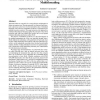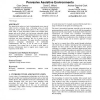316 search results - page 39 / 64 » How Children Can Design the Future |
ASPLOS
2006
ACM
13 years 11 months ago
2006
ACM
Transient faults are expected a be a major design consideration in future microprocessors. Recent proposals for transient fault detection in processor cores have revolved around t...
CHI
2010
ACM
14 years 2 months ago
2010
ACM
How can we best explore the range of users' reactions when developing future technologies that maybe controversial, such as personal healthcare systems? Our approach – Cont...
PETRA
2009
ACM
14 years 2 months ago
2009
ACM
The digital divide refers to a lack of technological access, part of which involves exclusion from a blooming arena of social interaction. People without mobile phones or PCs cann...
AICT
2006
IEEE
14 years 2 months ago
2006
IEEE
A software application has strong relationships with the business processes it supports. In the analysis phase those parts of the processes in which the software system is applied...
VRST
2006
ACM
14 years 1 months ago
2006
ACM
This paper focuses at the usage of neuromuscular electrical stimulation (NMES) for achieving pseudo-haptic feedback. By stimulating the motor nerves, muscular contractions can be ...


